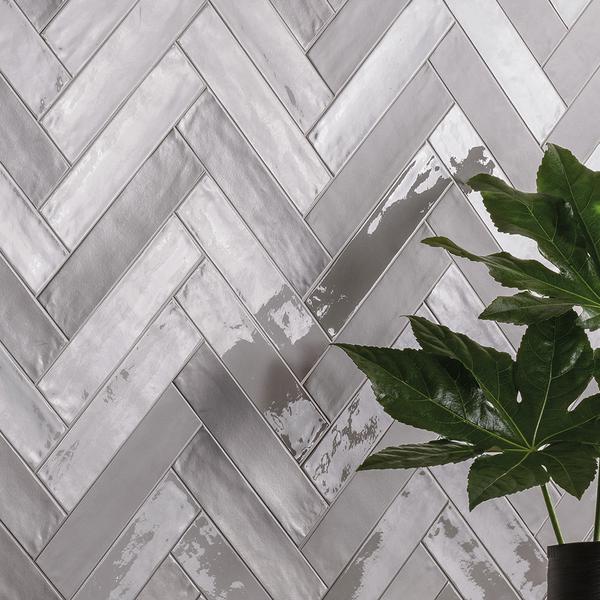Totalook: interview with the designer
Porcelain stoneware is a versatile, durable material capable of undergoing various treatments to alter its characteristics and make it correspond to our desires. Polishing and enameling are just a couple of the most used finishes on this material, and depending on the use, the modifications can have different impact.
In this article we will introduce to you one of the latest trends in the field: lapped porcelain stoneware. Achieved through a very particular and prestigious finish, with unparalleled elegance and brightness, this material has become one of the most beloved elements in interior design in recent years. But let’s discover together all about lapped finish!
We can talk about lapped porcelain stoneware when the original material undergoes the so-called lapping (or polishing) treatment. This solution involves a mechanical operation in which the imperfections in porcelain stoneware are eliminated, making the surface extremely shiny and smooth, almost resembling a mirror. Given the rough nature of more traditional porcelain stoneware, lapping completely transforms its appearance and characteristics, aesthetically bringing it closer to marble.
Following this treatment, the resulting floors will be shiny and glossy, suitable for various environments such as kitchens, dining rooms, entrances as well as bathrooms or living rooms, imparting a prestigious and classy character to your home.
It's important to also consider the possibility of obtaining, if requested, a matte polishing treatment for a different, distinctive, and refined effect.
Lapped porcelain stoneware preserves the nature of the original material, versatile and multifaceted, while ensuring a more elegant and classy aesthetic. The floors created with this process will therefore be perfect for every solution.
Lapped porcelain stoneware has become a must have for lovers of the refined aesthetics of marble and similar materials such as onyx or quartzite, as we see it stand out as the material of the moment in industry magazines and beyond. But is it always the best choice? To answer that, Emilgroup will guide you through the discovery of this captivating element!
Among the pros of polished porcelain stoneware, we certainly see the great shine and elegant appearance that this material can give to any environment. As you can see in some of our latest collections, such as Tele di Marmo Precious, its faithfulness to marble manages to enhance the colors and details of the surrounding furnishings making it perfectly suited to tastes, choices, and situations with a luxurious, shiny and refined aesthetic.
Increasingly sought after and desired, lapped porcelain stoneware coverings are still a lesser-known alternative in terms of their characteristics and specifications.
The lapping process, associated with the grinding of the edge of the tiles, is a treatment carried out to improve the aesthetics of stoneware, ensuring surfaces, as mentioned earlier, are smoother and shinier.
Specifically, when we talk about lapping, we refer to a mechanical process performed on the tile after firing. The machine capable of carrying out this operation on porcelain stoneware comes from the marble universe, adapted only in recent times to the tile industry. These tools perform a process similar to what has long been done on natural stone slabs. Polishing and lapping will make the surface mirror-like, smooth, and free of imperfections.
Rectification, on the other hand, is a complementary process to the aforementioned treatments, capable of making the edges of the tiles homogeneous, forming perfect 90° angles. Rectification is a process carried out on the edge of the tile after it has been produced, minimizing imperfections: at the end of firing, the tiles have irregular finishes, with more or less noticeable curves that are, with this treatment, leveled with milling cutters that make them smooth and precisely rectified. But how can we recognize a rectified tile? To understand if the tile has been properly rectified, it will be necessary to feel the edges with your hand: if they are smooth and without imperfections, then you're good to go!
Polished porcelain stoneware is a premium surface with many positive aspects, and its beauty deserves care and attention. Therefore, it is necessary to take a series of precautions to avoid damaging it.
The maintenance process for porcelain stoneware is crucial, starting from the moment it is installed. In fact, installers must ensure that no pebbles or pieces of glass are trapped in the soles of their shoes, as these could damage the material. After the completion of the work, for added protection against scratches, it is useful to use bio-adhesive rubber caps or felt pads to apply under the furniture. If the fully polished material is installed on the ground floor with direct access to outdoor areas, it would be advisable to use dirt barriers to prevent potential damage.
Avoiding generic and abrasive products is certainly the first point to keep in mind when cleaning lapped porcelain stoneware. Opting for neutral substances, preferably designed for this specific type of product, will ensure shiny surfaces. Adding hot water will also prevent the formation of annoying and hard-to-remove streaks.
Finally, once the initial installation is completed, it will be necessary to sweep the floor to remove any residue that could scratch the porcelain stoneware. It is also very important to ensure that the cleaning after the initial installation is carried out with expertise. Please see the instruction on the caring for the full lappato stoneware surfaces.
In conclusion, we can assure you that with careful care, your lapped porcelain stoneware coverings will be the classy touch to make your rooms shine!
11 January 2024
From our blog
